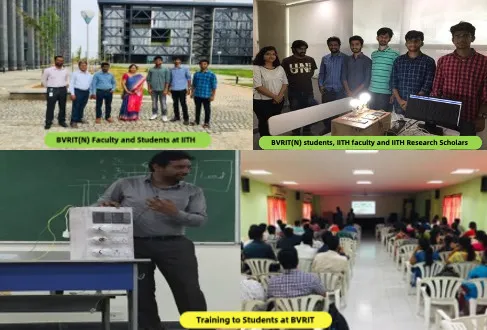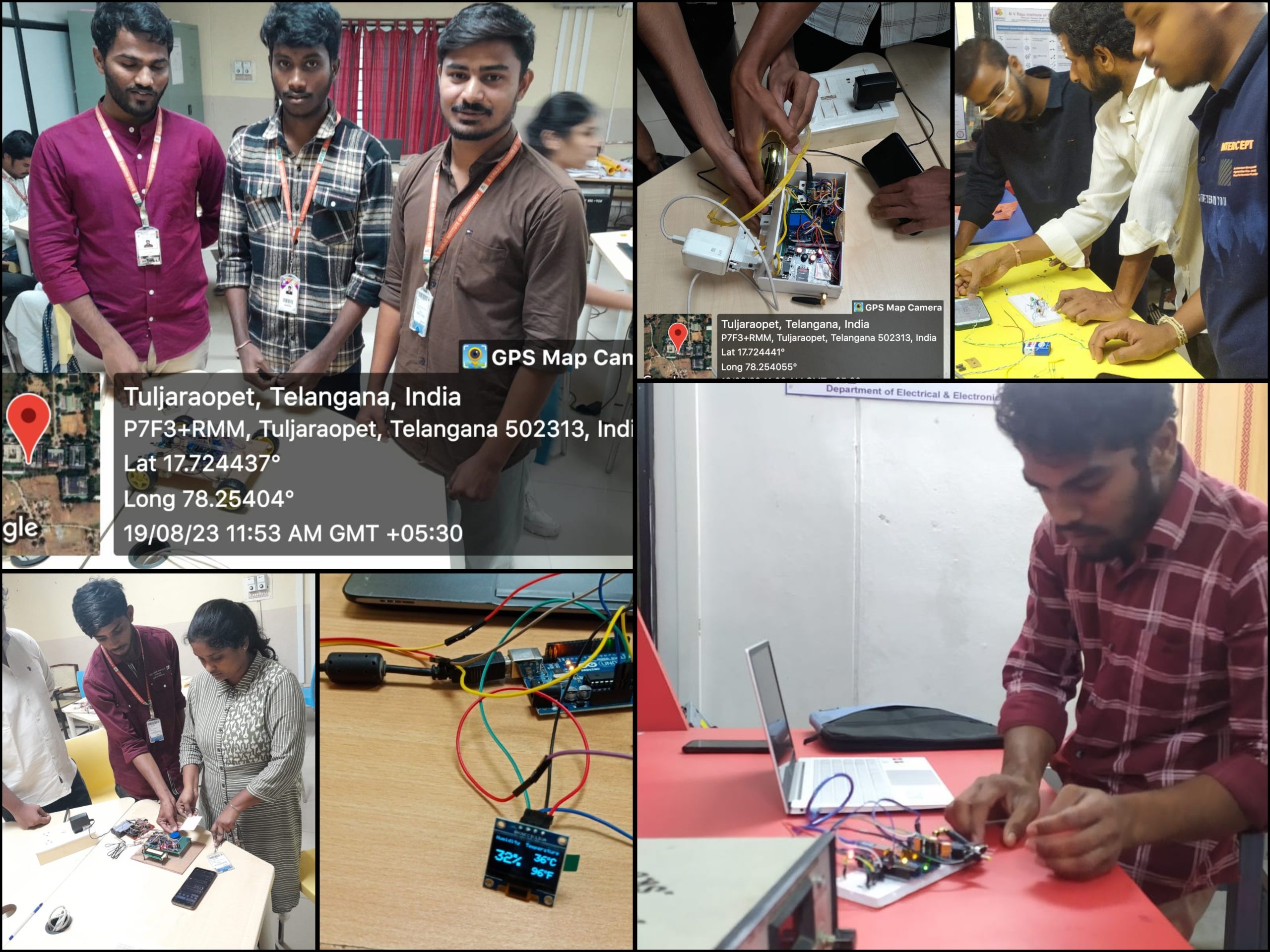Electrical engineering is concerned with the study and use of electricity, electronics, and electromagnetic, and is mostly concerned with large-scale electrical systems, power transmission, and motor control. Electrical engineering has progressed from Edison and Tesla’s basic electric circuits through Bode and Nyquist’s rocket science to the intricacy of IC, satellites, and communication networks. The demand for electrical energy in our country is rapidly expanding, necessitating the need for increased power generation. As a result, electrical engineers’ roles are becoming increasingly crucial in today’s world.
Department of EEE have the resources to give aspiring engineers with the training and expertise they need to make a significant contribution in this field. Initially, the curriculum offers students with a broad foundation upon which they may build their particular expertise. Professional engineers with a strong working understanding of analogue, digital, and power electronics, electrical machines, and power systems, with an emphasis on applications, have been produced in recent years. With well-equipped laboratories and a staff of skilled and motivated teaching members, the Department has an outstanding infrastructure to establish a pleasant academic atmosphere in which to offer quality education.
The department features a well-developed Research & Development facilities that is led by experienced academics. It also has a sufficient number of technically qualified and self-motivated personnel. The Department has strong ties with industry, and one of the benefits for our students is that they are in high demand, not only in the local market but also globally.
Special Projects:
- Design and development of lithium-ion battery packs for 2W/3W applications
- Hybridization of energy sources
- e-cycles development
- Thermal management of lithium-ion batteries
- Training and internship on EV technologies

About:
Training of students in installation of the PV modules, balance of systems and instruments. The measuring instruments used for this project use cutting edge technology and have been sourced by Elkem and Titan from leading vendors in the world. The performance of the modules in terms of energy generation and so on can be monitored from any part of the world. The Governments of India & Norway had signed a protocol some years ago for the promotion of various technologies including clean and green technologies.
BVRIT as the academic partner has entered into a three way tie up with Elkem solar, Norway (Research partner) and Titan Energy Systems Ltd (Industry Partner). Elkem Solar, Norway, have developed solar grade silicon cells that are converted into photovoltaic (PV) module.
Objectives:
- Exposure of students to state-of-the-art technology in terms of PV modules, measuring instruments, sensors, data acquisition with associated software and evaluation techniques
- Developing the analytical skills of students by giving them an opportunity to involve themselves in a long-term performance study and interpret/analyze the data acquired
- An excellent paradigm for industry, academia and R&D collaboration – a Win-Win situation for all.
- Such an initiative would constitute the first step in establishing a full-fledged Centre of Excellence for Solar Energy at BVRIT.

About:
Data analytics on the electrical parameters is needed in order to improve energy consumption efficiency and prevent adverse events such as power outage, short circuit etc.,. It also helps in protecting and increase the longevity of the electrical equipment. The electrical consumption data is measured usually using the multifunction meter(MFM) installed in residential or commercial buildings. In the commercial buildings, these meters are installed in the panel room (centralized) and in all floors/de- (decentralized). The extraction of data is the first step for the process of data analytics. In order to demonstrate the data retrieval process, a hardware lab set up is implemented using RS 485 communication interfaced multifunction meter (MFM). In addition to the MFM, certain modules (both hardware and software) used for the data extraction.
Objectives:
- Visualization of campus-network with real-time data
- Parameters to be monitored: Voltages (R, Y, B), Voltages (RY, YB, BR), currents (R, Y, B), Frequency,active power, reactive power, apparent power of all phases, power factor of all phases, energy consumption in KWH,using, IITH indigenously developed IoT module, Modbus RTU, class 0.2s & 1, computer server, large display unit for SCADA display of the network.
- Energy consumption alerting on vulnerabilities and reporting.
- Open Data platform for students for performing various energy data analytics and projects on machine learning (ML), artificial intelligence (AI) applications in smart
- Data collection and analysis of power distribution and eradication of unforeseen power shut off.
Outcomes:
- Website for monitoring the campus energy (intranet).
- Web based SCADA like display of single line diagram of entire campus.
- Further displays of realtime and historical data at each monitoring point.
- Plots of voltage, current, power of each metering point.
- Daily Energy Consumption reports.
- Meter-wise, block-wise.
- Weekly Energy Consumption.
- Monthly Energy Consumption reports.
- Email alerts:
- Daily, weekly and monthly.
- Over and Under voltage alerts.
- Power interruption report.
- Alert on the crossing of 80% of contracted maximum demand.
The following projects can be executed using the above hardware and software system
- Energy consumption analysis
- Data Analysis on Energy Monitoring Data
- Data driven management for Energy savings
- Campus Energy data Analytics
- Energy Data Analytics on BVRIT campus
- Energy data analysis
- Data driven Energy consumption analysis
- Data driven Energy consumption analysis for Reducing Tariff
- Data driven load scheduling

Vision:
To combine four different technologies, namely a wind solar hybrid system, a submersible motor pumping system, a street light system, and a drip irrigation system, into a full solution for a horticulture farmer, therefore benefiting both the farmer and society as a whole.
Objectives:
- 365 days uninterrupted, high-quality power.
- Power that is clean and does not pollute the environment.
- Agriculture labour expenses are reduced.
- No motors will be burned by low-quality electricity caused by voltage fluctuations.
- Saves 25% of the water needed for irrigation.
- Produces a 25% to 50% increase in crop output.
- Reduce global warming, conserve water, and boost horticultural crop yields.
Description:
The photovoltaic array consists of two 30V 8A panels interconnected in parallel. The planned photovoltaic system has a total capacity of 480W. The photovoltaic effect turns solar energy into electric energy, yielding DC voltage as a result. The output DC voltage is generated by a wind turbine with a total capacity of 700W and an average speed of 5m/s. The fundamental benefit of hybrid solar energy is that it collects energy from both solar and wind sources, using PV panels for solar energy and wind turbines for wind energy. Using the photovoltaic principle, a solar panel receives the sun’s rays and converts them into DC electricity. And also the wind turbine revolves owing to the force of the wind, and its rotor is connected to a generator, which simultaneously rotates and produces AC electricity.
Components:
- Wind mill,
- Solar panels,
- Charge controller,
- Auto Grid change over,
- Timer,
- Lead acid Batteries of 150 Ah,
- Inverter,
- Water pump and
- Lighting load.
Specifications:
CAPACITY: 1180 WATTS
WIND SYSTEM: 700WATTS, 23 A, 30 V.
PV SYSTEM: 480 WATTS, 16 A, 30 V.
SOLAR PANELS: Number of Panels-2, EACH RATING 30V, 8A, 240W.
Research Area:
- To analyze the load of Solar Wind Power Generation System with different loads.
- To analyze the power generation of Solar Wind Power Generation System from environmental conditions.
- To analyze the load of Solar Wind Power Generation System for different seasons.
- Experimental Load Analysis of Hybrid Solar Wind Power Generation System in Comparison with MATLAB/SIMULINK.
- Designing a multistage submersible motor that runs on the 850W clean power generated by WSHS unit.
- Designing automated electronic circuits for battery charge controller.
- Designing automated timer circuits to switch on and off the water supply to drip pipes by maintaining a pre-set pressure in the pipes.
OBJECTIVES:
- The primary objective of this program is to provide an exposure to the participants with the essentials of MATLAB and some of the toolboxes based on Power Systems, Power Electronics, Control Systems, Artificial Intelligence, Optimization, etc.
- Develop the conceptual and fundamental concepts of Machine Learning elements.
- Develop a basic understanding of all key components of MATLAB for ML development.
- Develop an understanding of Data Science and Analytics.
5. Understand different types of Machine learning-based algorithms.
LIST OF EXPERTISE (Sample):
- Introduction to MATLAB&SIMULIN
- Traffic Light Negotiation and Perception- Based Detection
- Smart Watering System with Internet of Things
- Portable Charging System for Electric Vehicles
- Path Planning for Autonomous Race Cars
- Green Hydrogen Production
- Deep Learning for UAV Infrastructure Inspection
- 3D Virtual Test Track for Autonomous Driving.
- Intelligent Fan Air Cooling System
- Battery Pack Design Automation.
OUTCOMES:
- To allow students to gain knowledge of current technological trends.
- To complete micro, mini, and major projects using MATLAB.
- To compete in inter-college tournaments and symposiums at the national and international
levels.
4. To publish their work in a variety of magazines, conferences, journals.

OVERVIEW:
The special lab on IoT Applications in Electrical Engineering caters to second-year undergraduate B.Tech students, providing a comprehensive exploration of the Internet of Things (IoT). Loaded with cutting-edge components, the lab serves as a bridge between traditional electrical engineering principles and contemporary smart systems, offering hands-on experience in integrating IoT technologies into electrical applications.
Key components include Arduino Uno, ESP32, Node MCU, and Raspberry Pi—microcontrollers at the core of IoT projects. Arduino Uno and ESP32 facilitate robust sensor interfacing, while Node MCU and Raspberry Pi bring advanced capabilities such as Wi-Fi connectivity and Linux-based programming to the forefront.
In the realm of sensors, students delve into the principles of temperature sensing for climate control and industrial applications, understand humidity sensing for environmental monitoring and HVAC systems, and explore gas concentration measurement for safety and pollution detection. Displays like OLED and LCD are incorporated for visual representation, crucial in IoT projects presenting real-time data and user interfaces.
The lab extends its focus to motor control systems, exposing students to different motors and their integration with microcontrollers. Understanding the significance of motor drivers for efficient control and energy management is a key facet. Additionally, students explore relay modules for controlling high-power electrical devices, simulating applications in home automation and industrial processes.
The practical application of these components is evident in various projects. Students engage in developing projects for smart lighting and appliance control, enabling remote management of lights, fans, and appliances using IoT devices. The lab also ventures into data collection and analysis, utilizing sensors for environmental research and monitoring. Further, students integrate sensors for health-related applications, such as heart rate monitoring and remote health monitoring. The lab’s scope extends to motor control systems for industrial automation and precision agriculture, implementing IoT solutions that incorporate soil moisture sensors and automated irrigation systems.
By combining theory with hands-on projects, the IoT Applications in Electrical Engineering Lab ensures students not only grasp the foundational principles but also gain practical expertise, preparing them for the dynamic landscape of IoT in the field of electrical engineering.
MOTIVATION:
This lab is not just a course; it’s an opportunity to dive into the heart of innovation, where theory meets practice, and classroom concepts come alive. In this specialized environment, you’ll gain hands-on experience with cutting-edge components like Arduino Uno, ESP32, Raspberry Pi, and various sensors. Witness the power of IoT as you design smart systems for home automation, environmental monitoring, healthcare, and industrial automation.
Why choose this lab? It’s not just about acquiring knowledge; it’s about cultivating skills that are in high demand in today’s job market. The Internet of Things is shaping the future, and this lab ensures you’re at the forefront of this technological revolution. You’ll not only understand the intricacies of IoT but also unleash your creativity in designing solutions for real-world challenges. From interactive sessions to industry collaborations, this lab offers a dynamic learning environment where theory seamlessly integrates with hands-on application.
OBJECTIVES:
- To form a bridge between the industry and academic institutions to update their knowledge.
- To understand the need of IoT in the research community software industry in India.
- To Appreciate differences between Big Data, cloud computing and IoT.
- To understand the innovative application’s needs such as smart city, smart health, smart manufacturing, Smart agriculture, etc..
- To train in designing and programming the IoT based System.
- To build industry capable talent, start-up community and entrepreneurial ecosystem for IoT.
- To understand the reduction of import dependency on IoT components and promote the action.
- To energize research mind-set and reduce costs in research and development by providing neutral and interoperable, multi-technology stack laboratory facilities.
- To provide environment for product creation, testing and also validation & incubation.
OUTCOMES:
- Understand the basic applications areas of IoT.
- Able to realize the revolution in Mobile devices, Cloud & Sensor networks, software agents.
- Understand design methodology and hardware platforms involved in IoT.
- Students will be able to design and apply effective techniques to create IoT based applications under in-house expert guidance.
- Students will become more industry ready, Technology gap between Industry and Institute will be reduced.
- Understand how to analyse and organize the data.
- Cloud connected IoT platform creates solutions that enable you to develop, deploy, manage IoT connected devices.
- IoT solutions enable near real time response and the ability to work in offline/intermittent connectivity to the applications in Industrial environments.
SCOPE:
The scope of the IoT Applications in Electrical Engineering Lab is expansive, offering a comprehensive exploration of the integration between traditional electrical engineering principles and cutting-edge IoT technologies. Students in this lab will delve into the practical applications of IoT components such as Arduino Uno, ESP32, Node MCU, and Raspberry Pi. The focus is on hands-on learning, allowing students to design, implement, and troubleshoot IoT systems.
MAJOR Components Available
- Arduino Uno, Node MCU, ESP 32
- Different types of sensors
- Relay Modules
- LCD Display and OLED
- Different types of motor with driver circuit
MAJOR EVENTS
- Hands-On Workshop/Expert Lectures: Hosting interactive workshops and expert lectures to explore effective ways of integrating practical teaching methods into classroom instruction. The focus will be on hands-on activities, providing educators with tangible approaches to teaching technical concepts in the IoT Applications in Electrical Engineering Lab.
Publications:
International Conference (SCOPUS Indexed):
- Rakesh, S. Saravanan, G. I. Loretta, S. Rao Balasani, D. S. Naga Malleswara Rao and K. M, “Solar Powered IoT Based Smart Agricultural Lawnmower Using Bluetooth/Android App,” 2023 International Conference on Energy, Materials and Communication Engineering (ICEMCE), Madurai, India, 14-15 December 2023, pp. 1-5, doi: 10.1109/ICEMCE57940.2023.10434097.
- Saravanan, M. Sameer, N. Deekshith, P. Parthasardhi, D. G. Kumar and M. Prameela, “Identification and Detection of Fault in Distribution System Using Arduino UNO,” 2nd International Conference on Edge Computing and Applications (ICECAA), organized by Gnanamani College of Technology, Namakkal, India, 19-21 July 2023, pp. 1223-1226, doi: 10.1109/ICECAA58104.2023.10212326.
- Saravanan, N. Guntuku, C. Akshaya, B. Prakash, D. G. Kumar and P. C. D. Goud, “A Novel Sensor based Water Quality Monitoring System using Internet of Things (IoT),” 4th International Conference on Electronics and Sustainable Communication Systems (ICESC), organized by Hindusthan Institute of Technology, Coimbatore, India, 06-08 July 2023, pp. 355-360, doi: 10.1109/ICESC57686.2023.10193597. ISBN: 979-8-3503-0009-3
- S.Saravanan, Ambathi Rishitha (20211A0201) “ Identification of parking space availability by using Arduino Uno for Smart City”, IEEE International Conference on Communication, Computing & Industry 4.0, November 2022.
Participation in
Competitions:
- Ambathi Rishitha (20211A0201) from 3rd year EEE-A and D. Praneeth from 3rd year EEE-B participated in the INDUiwai’2022 event organized by Sri Indu College of Engineering and Technology on September 24, 2022. They secured 1st Prize in the National Level Technical Symposium on Emerging Trends in Industrial IoT and Cyber Security issues 2022, showcasing a prototype of a Smart Car Parking System using IoT technology.
- Mukundam Shirisha (22215A0216) from II Year EEE A Section participated in VALIANT 2022, a National Level Student Technical Symposium organized by Vishnu Institute of Technology, Bhimavaram, held on December 22-23, 2022. She secured II Prize in the Tech MOD event.
Workshops:
- Sura Deepika (20211A0291), Palani Pavan Teja (21215A0215), Sai Teja. J (21215A0222), Sri Krishna Rithwik.D (21215A0226), students in the third year of EEE B Section, successfully participated in the IoT Teaser and IoT Workshop as part of the College’s research affiliate program – Batch -2, held from November 2022 to April 2023 in collaboration with IIIT Hyderabad and the Conduira platform.










